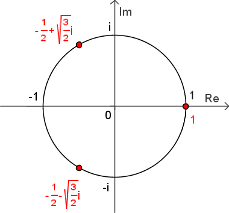डी मायवर का प्रमेय
डी मॉयवर का प्रमेय या डी मॉयवर का सूत्र (De Moivre's formula) समिश्र संख्याओं के घात (इन्डेक्स) से सम्बन्धित एक महत्वपूर्ण सूत्र है। इसका प्रतिपादन अब्राहम डी मॉयवर (Abraham de Moivre) ने किया था।
इस प्रमेय के अनुसार,
- <math>\left(\cos x+i\sin x\right)^n=\cos\left(nx\right)+i\sin\left(nx\right).\,</math>
जहाँ n कोई पूर्णांक (integer) है तथा x कोई भी समिश्र संख्या है। (अतः x के वास्तविक मान के लिये भी सत्य है)
इस सूत्र की महत्ता इस बात में है कि यह समिश्र संख्याओं को त्रिकोणमिति से जोड़ता है।'"cos x + i sin x"' को प्रयः '"cis x"' के संक्षिप्त रूप से भी व्यक्त किया जाता है।
उपपत्ति (Derivation)
डी मायवर का प्रमेय समिश्र विश्लेषण सम्बन्धी आयलरर के सूत्र से प्राप्त किया जा सकता है (यद्यपि डी मायवर का प्रमेय, आयलर के प्रमेय से पहले सिद्ध किया जा चुका था।)
- <math>e^{ix} = \cos x + i\sin x\,</math>
तथा चरघातांकी के नियम (exponential law) के अनुसार,
- <math>\left(e^{ix} \right)^n = e^{inx} .\,</math>
अत: यूलर के सूत्र के अनुसार,
- <math>e^{i(nx)} = \cos(nx) + i\sin(nx).\,</math>
गणितीय आगमन विधि से सिद्ध
यहाँ तीन अवस्थाएं सम्भव हैं :
- n > 0, के लिए हम गणितीय आगमन सिद्धान्त का उपयोग करते हैं। जब n = 1 हो तो यह स्वयंसिद्ध है क्योंकि वाम हस्थ व दक्षिण हस्थ व्यंजक समान हो जाते हैं। नियमानुसार हम मान लेते हैं कि किसी धन पूर्णांक k के लिए प्रमेय सही है अर्थात परिणाम सत्य है। तब हम लिख सकते हैं
- <math>\left(\cos x + i \sin x\right)^k = \cos\left(kx\right) + i \sin\left(kx\right). \,</math>
अब, n = k + 1 के लिए व्यंजक लिखने पर :
- <math>
\begin{alignat}{2}
\left(\cos x+i\sin x\right)^{k+1} & = \left(\cos x+i\sin x\right)^{k} \left(\cos x+i\sin x\right)\\
& = \left[\cos\left(kx\right) + i\sin\left(kx\right)\right] \left(\cos x+i\sin x\right) &&\qquad \mbox{by the induction hypothesis}\\
& = \cos \left(kx\right) \cos x - \sin \left(kx\right) \sin x + i \left[\cos \left(kx\right) \sin x + \sin \left(kx\right) \cos x\right]\\
& = \cos \left[ \left(k+1\right) x \right] + i\sin \left[ \left(k+1\right) x \right] &&\qquad \mbox{by the trigonometric identities}
\end{alignat} </math>
We deduce that the result is true for n = k + 1 when it is true for n = k. By the principle of mathematical induction it follows that the result is true for all positive integers n≥1.
When n = 0 the formula is true since <math>\cos (0x) + i\sin (0x) = 1 + i0 = 1</math>, and (by convention) <math>z^0 = 1</math>.
When n < 0, we consider a positive integer m such that n = −m. So
- <math>
\begin{align}
\left(\cos x + i\sin x\right)^{n} & = \left(\cos x + i\sin x\right)^{-m}\\
& = \frac{1}{\left(\cos x + i\sin x\right)^{m}}\\
& = \frac{1}{\left(\cos mx + i\sin mx\right)}\\
& = \cos\left(mx\right) - i\sin\left(mx\right)\\
& = \cos\left(-mx\right) + i\sin\left(-mx\right)\\
& = \cos\left(nx\right) + i\sin\left(nx\right).
\end{align} </math>
Hence, the theorem is true for all integer values of n.
कोज्या (cosine) एवं ज्या (sine) के लिये सूत्र
Being an equality of complex numbers, one necessarily has equality both of the real parts and of the imaginary parts of both members of the equation. If x, and therefore also <math>\cos x</math> and <math>\sin x</math>, are real numbers, then the identity of these parts can be written (interchanging sides) as
- <math>\begin{alignat}2
\cos(nx)&=\sum_{k=0}^{\lfloor n/2\rfloor}{\tbinom{n}{2k}}(-1)^k(\cos{x})^{n-2k}(\sin{x})^{2k}& &=\sum_{k=0}^{\lfloor n/2\rfloor}{\tbinom{n}{2k}}(\cos{x})^{n-2k}((\cos{x})^2-1)^k\\
\sin(nx)&=\sum_{k=0}^{\lfloor (n-1)/2\rfloor}{\tbinom{n}{2k+1}}(-1)^k(\cos{x})^{n-2k-1}(\sin{x})^{2k+1}& &=(\sin{x})\sum_{k=0}^{\lfloor(n-1)/2\rfloor}{\tbinom{n}{2k+1}}(\cos{x})^{n-2k-1}((\cos{x})^2-1)^k.\\
\end{alignat}</math> These equations are in fact even valid for complex values of x, because both sides are holomorphic functions of x, and two such functions that coincide on the real axis necessarily coincide on the whole complex plane. Here are the concretre instances of these equations for <math>n=2</math> and <math>n=3</math>:
- <math>\begin{alignat}2
\cos(2x) &= (\cos{x})^2 +((\cos{x})^2-1) &&= 2(\cos{x})^2-1\\
\sin(2x) &= 2(\sin{x})(\cos{x})\\
\cos(3x) &= (\cos{x})^3 +3\cos{x}((\cos{x})^2-1) &&= 4(\cos{x})^3-3\cos{x}\\
\sin(3x) &= 3(\cos{x})^2(\sin{x})-(\sin{x})^3 &&= 3\sin{x}-4(\sin{x})^3.\\
\end{alignat}</math> The right hand side of the formula for <math>\cos(nx)</math> is in fact the value <math>T_n(\cos x)</math> of the Chebyshev polynomial <math>T_n</math> at <math>\cos x.</math>
सामान्यीकरण (Generalization)
डी मॉयवर के सूत्र का जो स्वरूप सबसे उपर वर्णित किया गया है, उससे भी अधिक सामान्य स्थितिके लिये यह सत्य है। वस्तुतः यह सूत्र तब भी सत्य है जब z और w दोनो ही समिश्र संखायें हों।
ध्यान दीजिये कि
- <math>\left(\cos z + i\sin z\right)^w</math>
अनेक मानों वाला फलन (multivalued function) है, जबकि
- <math>\cos (wz) + i \sin (wz)\,</math>
नहीं। अतः निम्नलिखित कथन सत्य है:
- <math>\cos (wz) + i \sin (wz) \,</math> <math>\left(\cos z + i\sin z\right)^w\,</math> का एक मान है।
उपयोग
डी मॉयवर के सूत्र की सहायता से किसी भी समिश्र संख्या का nवाँ मूल (roots) निकाला जा सकता है। यदि <math>z</math> एक समिश्र संख्या है तो इसे ध्रुवीय स्वरूप में इस प्रकार से लिख सकते हैं:
- <math>z=r\left(\cos x+i\sin x\right),\,</math>
तब
- <math>
z^{{}^{\frac{1}{n}}}= \left[ r\left(\cos x+i\sin x \right) \right]^ {{}^{\frac{1}{n}}}= r^{{}^{\frac{1}{n}}} \left[ \cos \left(\frac{x+2k\pi}{n} \right) + i\sin \left(\frac{x+2k\pi}{n} \right) \right]
</math>
जहाँ k एक पूर्णांक है। z के n अलग-अलग मूल प्राप्त करने के लिये k के केवल उन्ही मानों को लिया जाता है जो 0 और (n-1) के बीच में होते हैं।
इन्हें भी देखें
- यूलर का सूत्र (Euler's formula)
- इकाई के मूल (Root of unity)
सन्दर्भ
- Milton Abramowitz and Irene A. Stegun, Handbook of Mathematical Functions, (1964) Dover Publications, New York. ISBN 0-486-61272-4. (p. 74).
बाहरी कड़ियाँ
- De Moivre's Theorem for Trig Identities by Michael Croucher, The Wolfram Demonstrations Project.

